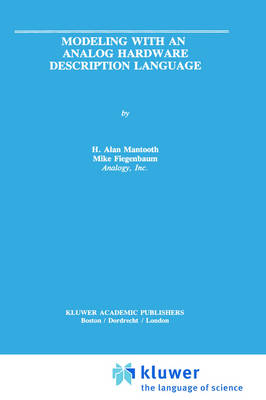
Modeling with an Analog Hardware Description Language
Seiten
1994
Springer (Verlag)
978-0-7923-9516-4 (ISBN)
Springer (Verlag)
978-0-7923-9516-4 (ISBN)
Modeling with an Analog Hardware Description Language spells out, in general terms, what modeling with an analog hardware description language (AHDL) adds to the existing field of computer simulation, using specific examples to develop this understanding.
The book is divided into three major sections:
Fundamentals of Modeling provides an overview of general modeling and simulation concepts that are used in subsequent chapters. These introductory chapters cover topics such as macromodels, behavioral models, primitive device models, modeling hierarchy, top-down design, non-electrical technologies, and the Newton--Raphson iterative simulation technique. These topics are presented to help further the understanding of what is needed to develop models in an AHDL.
Model Implementation begins to convey the implementation details of the MAST AHDL. The chapters in this section show how to use the governing equations of several commonly used models, along with equations that are readily available from well-known textbooks and papers. This information is provided in both tutorial and reference fashion, serving as an introduction to the basics of the MAST ADHL. Each chapter builds on the information from preceding chapters in order to demonstrate progressively more complex modeling concepts. This culminates with the diode and MOSFET models given in Chapter 9, which are intended to show the depth of the MAST language and which may be of interest to a more specialized segment of the modeling population.
Advanced Applications contains several examples of designs that use models written in the MAST ADHL. Each example makes use of concepts brought up in the first two sections. The main purpose of these chapters is to illustrate the importance of using an AHDL to enhance the power of computer simulations.
The book is divided into three major sections:
Fundamentals of Modeling provides an overview of general modeling and simulation concepts that are used in subsequent chapters. These introductory chapters cover topics such as macromodels, behavioral models, primitive device models, modeling hierarchy, top-down design, non-electrical technologies, and the Newton--Raphson iterative simulation technique. These topics are presented to help further the understanding of what is needed to develop models in an AHDL.
Model Implementation begins to convey the implementation details of the MAST AHDL. The chapters in this section show how to use the governing equations of several commonly used models, along with equations that are readily available from well-known textbooks and papers. This information is provided in both tutorial and reference fashion, serving as an introduction to the basics of the MAST ADHL. Each chapter builds on the information from preceding chapters in order to demonstrate progressively more complex modeling concepts. This culminates with the diode and MOSFET models given in Chapter 9, which are intended to show the depth of the MAST language and which may be of interest to a more specialized segment of the modeling population.
Advanced Applications contains several examples of designs that use models written in the MAST ADHL. Each example makes use of concepts brought up in the first two sections. The main purpose of these chapters is to illustrate the importance of using an AHDL to enhance the power of computer simulations.
Section 1: Fundamentals of Modeling. 1. Modeling: a Working Definition. 2. Modeling with an Analog HDL. 3. Macromodeling. 4. Top-Down Design. Section 2: Modeling Implementation. 5. Connecting Models to the MAST AHDL. 6. Netlists -- Using Hierarchy. 7. Basic Linear Devices. 8. Piecewise Linear and Table Lookup Modeling. 9. Modeling Nonlinear Devices. 10. Digital Modeling. 11. Modeling Mixed Analog-Digital Systems. 12. Advanced AHDL Capabilities. Section 3: Advanced Applications. 13. Electro-Mechanical Systems. 14. Motors. 15. Hydraulics. 16. Electro-Thermal Systems. 17. Magnetics. 18. Summary. Appendix A: Reference Information. Appendix B: MAST Template and Function Listings. Index.
| Erscheint lt. Verlag | 30.11.1994 |
|---|---|
| Reihe/Serie | The Springer International Series in Engineering and Computer Science ; 291 |
| Zusatzinfo | XX, 274 p. |
| Verlagsort | Dordrecht |
| Sprache | englisch |
| Maße | 156 x 234 mm |
| Themenwelt | Informatik ► Weitere Themen ► CAD-Programme |
| Technik ► Elektrotechnik / Energietechnik | |
| ISBN-10 | 0-7923-9516-6 / 0792395166 |
| ISBN-13 | 978-0-7923-9516-4 / 9780792395164 |
| Zustand | Neuware |
| Haben Sie eine Frage zum Produkt? |
Mehr entdecken
aus dem Bereich
aus dem Bereich
Buch | Softcover (2023)
Beuth (Verlag)
CHF 138,60
Einführung in die Geometrische Produktspezifikation
Buch | Softcover (2023)
Europa-Lehrmittel (Verlag)
CHF 27,90


